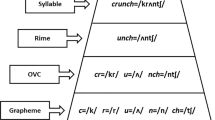Summary
It has been known for nearly 100 years that single words presented tachistoscopically are better recognized than arbitrary letter strings. The present experiments investigate the impact of the morphological structure of words and of word frequency on the word superiority effect. It has been shown that inflected word forms show higher reaction time and error scores in the lexical decision task and higher error scores in the Reicher-Wheeler paradigm. Word frequency also determines lexical decision time. However, no frequency effect in the Reicher-Wheeler paradigm could be found. The results are discussed in the framework of McClelland and Rumelhart's (1981) model of context effects in letter search.
Similar content being viewed by others
References
Baron, J. (1978). The word superiority effect: Perceptual learning from reading. In: Estes W. (ed), Handbook of Learning and Cognitive Processes (pp 131–167). Hillsdale: Lawrence Erlbaum.
Baron, J., & Thurston, I. (1973). An analysis of the word superiority effect. Cognitive Psychology, 4, 207–228.
Cattell, J.M. (1886). The time taken up by cerebral operations. Mind 11, 220–242; 377–392; 524–538.
Clark, H. (1973). The language-as-fixed-effect-fallacy: A critique of language statistics in psychological research. Journal of Verbal Learning and Verbal Behavior, 15, 257–266.
Coleman, E.B. (1978). Generalization effects vs. random effects: Is sZ tl a source of type 1 or type 2 error? Journal of Verbal Learning and Verbal Behavior, 18, 243–256.
Foote, W., & Havens, L.C. (1965). Stimulus frequency: Determinant of perception or response? Psychonomic Science, 2, 153–154.
Gibson, E. & Guinet, L. (1971). Perception of inflections in brief visual presentations of words. Journal of Verbal Learning and Verbal Behavior, 10, 182–189.
Gibson, E., Pick, A., Osser, H., & Hammond, M. (1962). The role of grapheme-phoneme-correspondence in the perception of words. American Journal of Psychology, 75, 554–570.
Gräbnitz, V. (1982). Häufigkeitsuntersuchungen zum ‚Korpus der deutschen Gegenwartssprache’. Master's thesis. Institut f. Phonetik & Sprachliche Kommunikation, University of Munich.
Günther, H. (1983a). Studien zur visuellen Worterkennung. Forschungsberichte des Instituts für Phonetik & Sprachliche Kommunikation der Universität München (FIPKM), 18, 1–190.
Günther, H. (1983b). Zur methodischen und theoretischen Notwendigkeit zweifacher statistischer Analyse sprachpsychologischer Experimente. Sprache & Kognition, 2, 279–285.
Henderson, L. (1980). Is there a lexicality component in the word superiority effect? Perception & Psychophysics, 28, 179–184.
Henderson, L. (1982). Orthography and Word recognition in Reading. London: Academic Press.
Johnston, J.C. (1978). A test of the sophisticated guessing theory. Cognitive Psychology, 10, 123–153.
Hockett, C. (1954). Two models of grammatical description. Word 10, 210–231. Again in: M. Joos (ed.): Readings in Linguistics I (1966), 386–399.
Kaeding. F.W. (1898). Häufigkeitswörterbuch der deutschen Sprache. Berlin.
Lukatela, G., Gligorijević, B., Kostić, A., & Turvey, M.T. (1980) Representation of inflected nouns in the internal lexicon. Memory & Cognition, 8, 415–423.
Manelis, L. (1974). The effect of meaningfulness in tachistoscopic word perception. Perception & Psychophysics, 16, 182–192.
Manelis, L. (1977). The effect of frequency and meaningfulness in tachistoscopic word perception. American Journal of Psychology, 90, 296–280.
Massaro, D.W., Taylor, G.A. Venezky, R.L., Jastrzembski, J.E., & Lucas, P.A. (1980). Letter and Word Perception. Amsterdam: North Holland.
Matthews, P.H. (1974). Morphology. An Introduction to the Theory of Word Structure. Cambridge: UP.
McClelland, J.L., & Johnston, J.C. (1977). The role of familiar units in the perception of words and nonwords. Perception & Psychophysics, 22, 249–261.
McClelland, J.L., & Rumelhart, D.E. (1981). An interactive activation model of context effects in letter perception. Part I: An account of basic findings. Psychological Review, 88, 375–407.
Miller, G.A., Bruner, J.S., & Postman, L. (1954). Familiarity of letter sequence and tachistoscopic identification. Journal of General Psychology, 50, 129–139.
Murell, G. & Morton, J. (1974). Word recognition and morphemic structure. Journal of Experimental Psychology, 102, 963–968.
Ortmann, W.D. (1975). Hochfrequente deutsche Wortformen I. München: Goethe Institut.
Reicher, G.M. (1969). Perceptual recognition as a function of meaningfulness of stimulus material. Journal of Experimental Psychology, 81, 274–280.
Reichling, A. (1935). Het woord. Nijmegen.
Rumelhart, D.E., & McClelland, J.L. (1982). An interactive model of context effects in letter perception: Part II. The contextual enhancement effect and some tests and extensions of the model. Psychological Review, 89, 60–94.
Spoehr, K. (1978). Phonological encoding in visual word recognition. Journal of Verbal Learning and Verbal Behavior, 17, 127–141.
Spoehr, K., & Smith, E.E. (1975). The role of orthographic and phonotactic rules in perceiving letter patterns. Journal of Experimental Psychology: Human Perception & Performance, 1, 21–34.
Taft, M. (1981). Prefix stripping revisited. Journal of Verbal Learning and Verbal Behavior, 20, 289–297.
Taft, M., & Forster, K.I. (1976). Lexical storage and retrieval of polymorphemic and polysyllabic words. Journal of Verbal Learning and Verbal Behavior, 15, 607–620.
Whaley, C.P. (1978). Word-nonword-classification time. Journal of Verbal Learning and Verbal Behavior, 17, 143–154.
Wheeler, D.D. (1970). Processes in word recognition. Cognitive Psychology, 1, 59–85.
Author information
Authors and Affiliations
Additional information
This paper is mainly (Experiments I and III) based on the first author's ‘Habilitationsschrift’ from October, 1982 (cf. Günther 1983a).
Rights and permissions
About this article
Cite this article
Günther, H., Gfroerer, S. & Weiss, L. Inflection, frequency, and the word superiority effect. Psychol. Res 46, 261–281 (1984). https://doi.org/10.1007/BF00308888
Received:
Issue Date:
DOI: https://doi.org/10.1007/BF00308888




